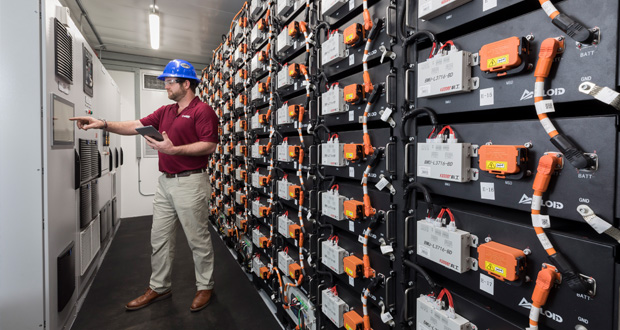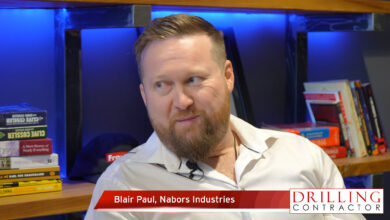2023 IADC Chairman: Moderated growth may create healthier business environment for drillers in coming years
Drilling contractors focusing on rig upgrades, not newbuilds, as industry heads into what will hopefully be a longer upcycle

By Linda Hsieh, Editor & Publisher
We’re at an exciting time in the drilling industry – not only because rig counts and dayrates have both been going up but also because we’re poised for the possibility of a multi-year upcycle, depending on how the economies in North America, Europe and China evolve in the near term. A longer period of stability is exactly what this industry needs, said Andy Hendricks, 2023 IADC Chairman and Patterson-UTI Energy President and CEO.
“If you look over the past decade, we’ve gone through at least three very short-lived cycles in the onshore sector, which creates a lot of challenges from a drilling contractor’s point of view,” Mr Hendricks said. “It doesn’t allow companies to recover financially, and it stifles technology growth. But most importantly, it negatively impacts our employees. Every time we go through one of these cycles, we have to rebuild our employee base. A multi-year cycle will be very healthy for both drilling contractors and other service companies, whether in the North American onshore, international or offshore regions.”
The reason Mr Hendricks is bullish about a longer upturn, he said, is that there has been a fundamental change in the way public E&P operators manage their business.
“Several times over the past decade, US producers have ramped up production and chased growth because that’s what their shareholders incentivized them to do. In doing so, it really led to overproduction, which then led to challenges in the global oil markets,” he said. “But now, US producers are focusing much more on returning cash to shareholders. This is actually a huge positive for our industry, as they have been growing but with moderation.”
Drilling contractors and other oilfield service companies are also aligning with this philosophy, prioritizing things like dividends, share buybacks and debt repayment.
“There’s this belief out there that drilling contractors have overbuilt the market. Well, not necessarily,” Mr Hendricks remarked. “We’ve just tried to stay aligned with our customers through these very short cycles. Now that our customers are exhibiting moderated growth, drilling contractors, too, will exhibit moderated growth. This creates an environment where we’ll likely see a much healthier business environment, possibly for the next few years.”
As a result of this capital discipline, North American onshore drilling contractors appear to have no plans to start a newbuild frenzy this time – even though the market is tight and top-tier drilling rigs have been practically sold out since mid-2022. The last newbuild cycle, which ended in 2015, was essentially a retooling of the industry with AC high-spec rigs, but that transition is no longer necessary.
“There’s no need to build new rigs. We’d rather just work the rigs that we have,” Mr Hendricks said.
That doesn’t mean there isn’t capacity to add rigs, he added, but drilling contractors are focusing instead on upgrading and reactivating existing rigs. At Patterson-UTI, for example, while all of its rigs are at a minimum AC, high-spec rigs, additional work is ongoing to take drilling rigs built before 2013 and make them full super-spec rigs. These can be structural upgrades or other work related to the rig’s electrical or circulating systems.
“That’s what we’ve been doing for the last year and a half, and we’ll continue doing that for the foreseeable future because we just don’t see the need to build new rigs,” Mr Hendricks said.
Facing challenges on people, emissions
While a multi-year upcycle will be positive for the drilling industry, it will also bring associated challenges. Among the most important will be staffing, especially for entry-level rig crews.
“The type of work we do – working outside in the weather and being away from home for 14 days at a time – it’s not appealing to some people,” Mr Hendricks said, adding that even when companies find individuals who are willing to try it, many leave within the first 30 days. “They try it out, and they say, ‘It’s not for me.’ Turnover at the entry-level position is definitely one of our biggest challenges in the US onshore drilling space as an industry.”
Automation – which has seen significant investments from drilling contractors in the past decade – is not yet reducing the number of people required to operate a drilling rig. A drilling rig still requires a lot of manual labor, not just during drilling or connections but also during rig moves. “Outside of a few very interesting prototypes, there’s not yet a wholesale automation of things like pipe handling in the onshore space that would allow for a reduction in the crew size,” Mr Hendricks said.
In fact, the number of people that work on a drilling rig in the US has only grown in the past four years. “It’s because of the intensity of the drilling operation, which drives the need for extra personnel on locations to manage all the tasks around the drilling operation and keep up with the rig maintenance.” For example, in the Permian Basin, Patterson-UTI’s annual horizontal footage drilled has grown by 160% over the past five years.
For drilling contractors, Mr Hendricks said he believes the primary value proposition of automatin existing rig systems is getting repeatability of the best-possible operation. Consistency around tasks like how the bit is set on bottom and how to steer the well, irrespective of the human driller’s level of experience, will help contractors to achieve higher efficiency across entire rig fleets. Then, the eventual automation of pipe handling will eliminate the interaction of humans and machines in the red zone.
Emissions reduction will be another key challenge for drilling contractors over the next few years. Patterson-UTI has been working at the leading edge of these efforts, launching innovations like EcoCell. This lithium battery hybrid power management system “allows the rig to act more like a hybrid vehicle because it’s not relying on engine power all the time and reduces fuel usage and emissions,” Mr Hendricks said. “I believe that, by working with the E&Ps, we can continue to make a difference and reduce emissions at the wellsite through technology and innovation.”
Parallel efforts are also ongoing around using highline power and natural gas as alternatives to diesel, which have become more routine onshore.
While drilling contractors will continue to invest in emission-reduction efforts and technologies like these, Mr Hendricks said there’s still a big question when it comes to the future of emissions reporting requirements: Who owns the emissions from the prime movers, like the generators, on a drilling rig?
“As a drilling contractor, we don’t determine the specification of the operation. We don’t determine how many generators are required. We don’t determine if a generator gets replaced by a lithium battery solution. We don’t determine the fuel source. Those are all specified by the E&P company,” Mr Hendricks explained.
This is a looming challenge that will only become more important as investors, regulators and the public continue to scrutinize emissions levels in the coming years. Mr Hendricks said he believes the drilling industry will need to consider who is the real owner of these emissions and urged companies to have discussions that could lead to an industry consensus among drilling contractors, service providers and E&Ps.
Goals as IADC Chairman
Looking at his term as IADC Chairman, Mr Hendricks said he is excited about leading a healthy and thriving industry as the association’s members work to advance safe working conditions for everyone on location, improve the onboarding of new employees and continue to push the limits of new drilling technologies.
Compared with the first time he served as IADC Chairman in 2017, he believes the optimism permeating the industry today will drive a more productive and energetic term in 2023. “I’m certainly earmarking to travel to a number of meetings and conferences in various parts of the world so I can meet with IADC members and hear what their concerns are. We want to make sure that IADC’s programs are addressing the needs of our global membership.”
Mr Hendricks also expressed strong support for IADC’s ongoing efforts to promote the drilling industry’s value to external stakeholders. Being able to demonstrate our value to society and improving our public image will be essential to recruiting young talent, he said.
“I applaud IADC’s efforts with universities and the student chapter program in terms of getting the message out on what we do and why it’s important,” he said. “When I meet with students at IADC meetings, you don’t just meet students in petroleum engineering. There’s also chemical engineers, mechanical engineers, electrical engineers – you get a cross-section, and I think that’s hugely important to help feed talent into our industry.”
Regardless of the public’s perception of our industry, however, the fact remains that the world needs oil and gas. While many are choosing to focus solely on the energy transition and renewables, people who work in this industry know that it’s not really a transition but an expansion of global energy requirements for the foreseeable future.
“The discussion should not be pitting one energy source against another. As the world’s population grows, we’re going to need all energy sources,” Mr Hendricks said. “Our industry may not be loved, but we’re needed. And we’re going to do our best to help meet the world’s energy needs in a safe and sustainable way. I am proud of our industry’s ability to produce affordable energy that makes peoples’ lives better.” DC




